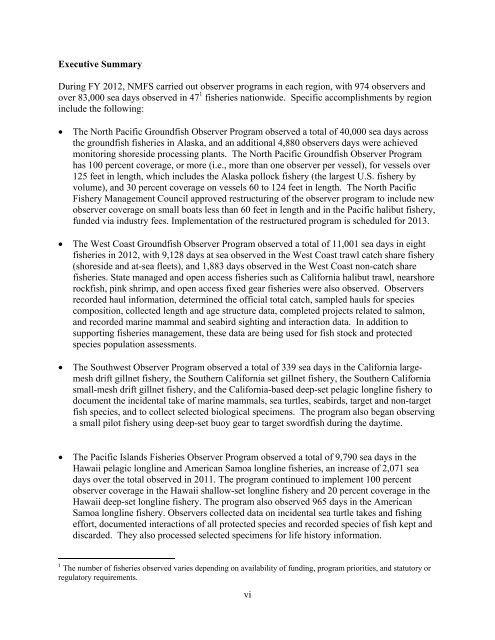National Observer Program Annual Report - Office of Science and ...
National Observer Program Annual Report - Office of Science and ...
National Observer Program Annual Report - Office of Science and ...
Create successful ePaper yourself
Turn your PDF publications into a flip-book with our unique Google optimized e-Paper software.
Executive Summary<br />
During FY 2012, NMFS carried out observer programs in each region, with 974 observers <strong>and</strong><br />
over 83,000 sea days observed in 47 1 fisheries nationwide. Specific accomplishments by region<br />
include the following:<br />
<br />
<br />
<br />
The North Pacific Groundfish <strong>Observer</strong> <strong>Program</strong> observed a total <strong>of</strong> 40,000 sea days across<br />
the groundfish fisheries in Alaska, <strong>and</strong> an additional 4,880 observers days were achieved<br />
monitoring shoreside processing plants. The North Pacific Groundfish <strong>Observer</strong> <strong>Program</strong><br />
has 100 percent coverage, or more (i.e., more than one observer per vessel), for vessels over<br />
125 feet in length, which includes the Alaska pollock fishery (the largest U.S. fishery by<br />
volume), <strong>and</strong> 30 percent coverage on vessels 60 to 124 feet in length. The North Pacific<br />
Fishery Management Council approved restructuring <strong>of</strong> the observer program to include new<br />
observer coverage on small boats less than 60 feet in length <strong>and</strong> in the Pacific halibut fishery,<br />
funded via industry fees. Implementation <strong>of</strong> the restructured program is scheduled for 2013.<br />
The West Coast Groundfish <strong>Observer</strong> <strong>Program</strong> observed a total <strong>of</strong> 11,001 sea days in eight<br />
fisheries in 2012, with 9,128 days at sea observed in the West Coast trawl catch share fishery<br />
(shoreside <strong>and</strong> at-sea fleets), <strong>and</strong> 1,883 days observed in the West Coast non-catch share<br />
fisheries. State managed <strong>and</strong> open access fisheries such as California halibut trawl, nearshore<br />
rockfish, pink shrimp, <strong>and</strong> open access fixed gear fisheries were also observed. <strong>Observer</strong>s<br />
recorded haul information, determined the <strong>of</strong>ficial total catch, sampled hauls for species<br />
composition, collected length <strong>and</strong> age structure data, completed projects related to salmon,<br />
<strong>and</strong> recorded marine mammal <strong>and</strong> seabird sighting <strong>and</strong> interaction data. In addition to<br />
supporting fisheries management, these data are being used for fish stock <strong>and</strong> protected<br />
species population assessments.<br />
The Southwest <strong>Observer</strong> <strong>Program</strong> observed a total <strong>of</strong> 339 sea days in the California largemesh<br />
drift gillnet fishery, the Southern California set gillnet fishery, the Southern California<br />
small-mesh drift gillnet fishery, <strong>and</strong> the California-based deep-set pelagic longline fishery to<br />
document the incidental take <strong>of</strong> marine mammals, sea turtles, seabirds, target <strong>and</strong> non-target<br />
fish species, <strong>and</strong> to collect selected biological specimens. The program also began observing<br />
a small pilot fishery using deep-set buoy gear to target swordfish during the daytime.<br />
<br />
The Pacific Isl<strong>and</strong>s Fisheries <strong>Observer</strong> <strong>Program</strong> observed a total <strong>of</strong> 9,790 sea days in the<br />
Hawaii pelagic longline <strong>and</strong> American Samoa longline fisheries, an increase <strong>of</strong> 2,071 sea<br />
days over the total observed in 2011. The program continued to implement 100 percent<br />
observer coverage in the Hawaii shallow-set longline fishery <strong>and</strong> 20 percent coverage in the<br />
Hawaii deep-set longline fishery. The program also observed 965 days in the American<br />
Samoa longline fishery. <strong>Observer</strong>s collected data on incidental sea turtle takes <strong>and</strong> fishing<br />
effort, documented interactions <strong>of</strong> all protected species <strong>and</strong> recorded species <strong>of</strong> fish kept <strong>and</strong><br />
discarded. They also processed selected specimens for life history information.<br />
1 The number <strong>of</strong> fisheries observed varies depending on availability <strong>of</strong> funding, program priorities, <strong>and</strong> statutory or<br />
regulatory requirements.<br />
vi

















